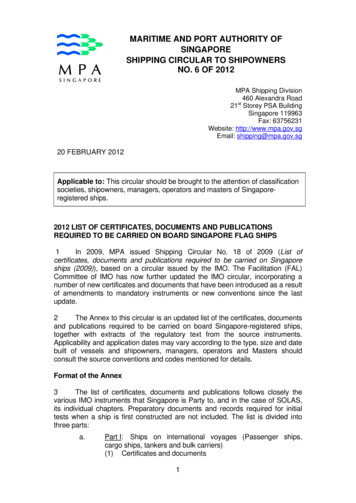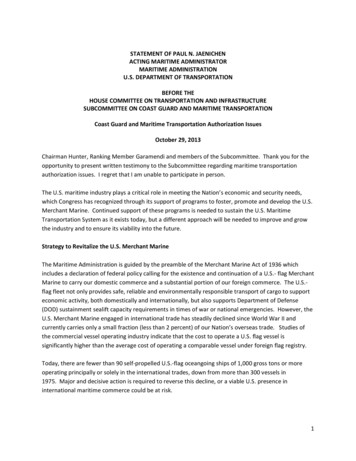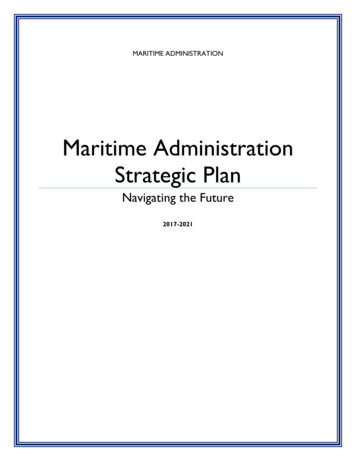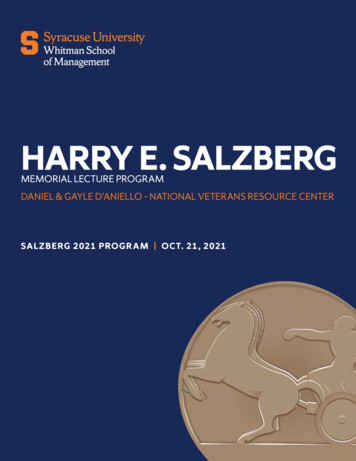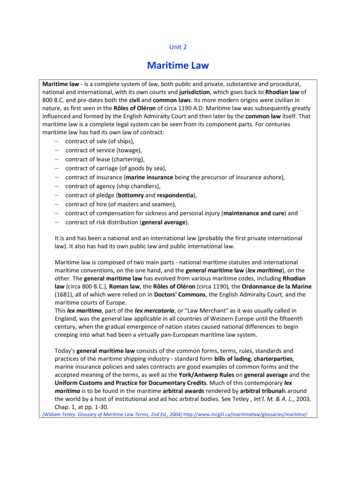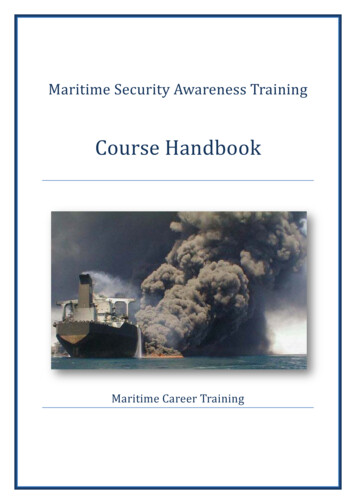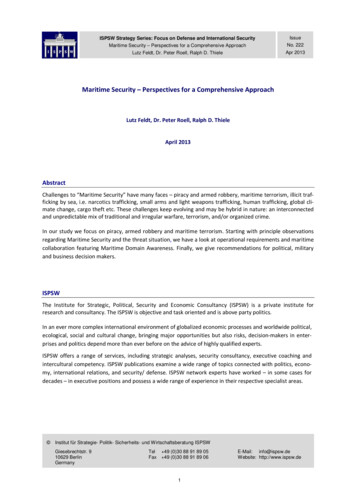
Transcription
Maritime Law:A Basic Introduction for LandLubbing Lawyers
A Bit of History: Why is Maritime Law Different?Circa 800 B.C., Rhodian Maritime Code is known to be developed"I, indeed, am Lord of the world, but the law is lord of the sea. Let it bejudged by Rhodian Law, prescribed concerning nautical matters, so far as noone of our laws is opposed." Emperor Antoninus (138-161 A.D.) as reportedin the Digest of JustinianSee Maritime Law as a Mixed Legal System (with Particular Reference to the Distinctive Nature of American Maritime Law, Which Benefits from Both Its Civil and Common Law Heritages), 23 Tul. Mar. L. J. 317See William Tetley, Q.C., THE GENERAL MARITIME LAW - THE LEX MARITIMA , 20 Syracuse J. Int'l L. & Com. 105 Spring 1994
“The judicial Power shall extend to all Cases, in Law and Equity, arisingunder this Constitution, the Laws of the United States, and Treaties made, orwhich shall be made, under their Authority;—to all Cases affectingAmbassadors, other public Ministers and Consuls;—to all Cases ofadmiralty and maritime Jurisdiction;” U.S. Constitution, Article III,Section 2.
What is Maritime Law? What is Not?1. Trouble Defining “Navigable Waters”2. Defining “Maritime Contracts”Norfolk Southern Railway Co. v. Kirby is a perfect example of the surprisingly lines.
An Overview of the Industry
International v. DomesticContainers, Dry Bulk, OtherBarge v. ShipBlue Water v. Brown Water
rmance/216906/bts-ppfsp-ar-congress-2017.pdf
WHO ARE THE CONTAINER CARRIERS1. A.P. Moller-Maersk (Maersk) [ 18%]2. Mediterranean Shipping Company (MSC) [ 16%]3. COSCO [ 13]4. CMA CGM S.A. [ 11%]5. Hapag-Lloyd [ 7%]6. Ocean Network (ONE) [ 7%]7. Evergreen Marine Corp. [ 5%]from ntainer-shipping-companies-in-the-world-1370h.htm
Other Industry PlayersThe StevedoresRailroadsTrucking/DrayageP&I ClubsNVOCC/Brokers
Maritime Shipping Law 101Always start with the contract!For most maritime transportation that is the “Bill of Lading.”We are going to use the Bill of Ladingfrom “Blue Anchor” which is a NVOCC
In most cargo litigation—this is the KEY.How many packages?How are they described?Why does it matter so much?You will see when we get to the Terms and Conditions
The reverse side of a Bill of Lading is anamazing feat. In a normal sized font, theTerms and Conditions are 29 pages long!There are some Key sections whenthinking about cargo claims:1) Himalaya clause Sub-Contracting/Indemnities2) Venue/Choice of Law
5. SUB-CONTRACTING AND INDEMNITIES5.1 The Carrier shall be entitled to sub-contract on any terms whatsoever the whole or any part of the Carriage and theMerchant agrees (to the extent that the Merchant is entitled to bring claims against Sub-Contractors) that any SubContractor can, at its option, apply its own terms of contract with the Carrier to defend claims brought by the Merchant.5.2 The Merchant undertakes: (a) that no claim or allegation shall be made against any Sub-Contractor whatsoever,whether directly or indirectly, which imposes or attempts to impose upon any Sub-Contractor any liability whatsoever inconnection with the Goods or the Carriage of the Goods, whether or not arising in contract, bailment, tort, negligence,breach of express or implied warranty or otherwise; and (b) if any claim or allegation should nevertheless be madeagainst a SubContractor, to Indemnify the Carrier against all consequences thereof.5.3 Without prejudice to the other provisions in this Clause 5, every Sub-Contractor shall have the benefit of allprovisions herein benefiting the Carrier including clause 21 hereof, the jurisdiction and law clause, as if this bill of lading(including Clause 21 hereof) were expressly for its benefit and in entering into this contract the Carrier, to the extent ofthese provisions, does so not only on his own behalf but also as agent or trustee for such Sub-Contractor and such SubContractor shall to this extent be or be deemed to be parties to this contract.
6.1(a) CARRIER’S LIABILITY/US CARRIAGEFor US Carriage this bill of lading shall have effect subject to the provisions of COGSAand to the Pomerene Act regardless of whether said Act would apply of its own force.The provisions of COGSA are incorporated herein and save as otherwise providedherein shall apply the entire time the Goods are in the Carrier's custody, including beforeloading and after discharge as long as the Goods remain in the custody of the Carrier orits Sub-Contractor, including Goods carried on deck. Nothing contained herein is to bedeemed as surrender by the Carrier of its rights, immunities, exemptions or limitationsor an increase of any of its responsibilities or liabilities under COGSA. Except forclause 6.2, every other term, condition, limitation, defence and liberty whatsoevercontained in this bill of lading shall apply to USCarriage.
The Carriage of Goods by Sea Act (“COGSA”) is the statute that governs most claimsfor damaged cargo aboard a vessel. Its most important feature is that COGSA § 4(5)*provides that a carrier will not “in any event be or become liable for any loss ordamage to or in connection with the transportation of goods in an amount exceeding 500 per package” unless the shipper declares a higher value on the goods.*COGSA was formerly located at 46 U.S.C. Appx. § 1301. Because of arecodification that eliminated the appendix to Title 46, the text of COGSA is nowlocated in the Notes of 46 U.S.C. § 30701.
COGSA also has a 1 YEAR time bar."In any event the carrier and the ship shall be discharged from allliability in respect of loss or damage unless suit is brought within oneyear after delivery of the goods or the date when the goods shouldhave been delivered "COGSA Section 6, Paragraph 6
6.3 (d) Notice of Loss or DamageThe Carrier shall be deemed prima facie to have delivered the Goods asdescribed in this bill of lading unless notice of loss of, or damage to, theGoods, indicating the general nature of such loss or damage, shall have beengiven in writing to the Carrier or to his representative at the place of deliverybefore or at the time of removal of the Goods into the custody of the Personentitled to delivery thereof under this bill of lading or, if the loss or damageis not apparent, within three consecutive days thereafter.
Blue Anchor (21.1) For US Carriage, this bill of lading is governed by United States law and the United States Federal Court of the Southern Districtof New York has exclusive jurisdiction to hear all disputes hereunder.Maersk (26): For shipments to or from the U.S. any dispute relating to this bill of lading shall be governed by U.S. law and the United States FederalCourt of the Southern District of New York COSCO (27): Where the shipment covered by this Bill of Lading is to or from the United States of America (including its districts, territories andpossessions), all claims arising hereunder must be brought and heard exclusively in the United States District Court for the Southern District of NewYork BUT .CMA CGM (31): All claims and actions arising between the Carrier and the Merchant in relation with the contract of Carriage evidenced by thisBill of Lading shall be brought before the Tribunal de Commerce de Marseille and no other Court shall have jurisdiction with regards to any suchclaim or action. Notwithstanding the above, the Carrier is also entitled to bring the claim or action before the Court of the place where the defendanthas his registered office.Hapag-Lloyd (25): All claims and actions arising between the Carrier and the Merchant in relation with the contract of Carriage evidenced by thisBill of Lading shall be brought before the Tribunal de Commerce de Marseille and no other Court shall have jurisdiction with regards to any suchclaim or action. Notwithstanding the above, the Carrier is also entitled to bring the claim or action before the Court of the place where the defendanthas his registered office.
MARITIME LAW BEYOND CARGO CLAIMS1.2.3.4.Personal Injury ClaimsSupplemental Rules of AdmiraltyMaritime LiensVessel Arrests
Personal Injury ClaimsWho got injured?The lines are hard to draw!
WHO GOT HURT?RELEVANT STATUTE“Seaman”Jones Act/UnseaworthinessLongshoreman or HarborworkerLHWCALand-basedState Worker’s Compensation Actor “General Maritime Law”
Jones ActUnseaworthiness LHWCAGeneralMaritime LawState eight)Strict liabilityNo-FaultFault-BasedNo-FaultJuryWhen with JonesActAdministrativeLaw JudgeJury, unlessbrought “inadmiralty”No JuryState or federalcourt; noremovalState or federalFederal Agencycourt; no removalwith Jones ActState or Federalunless againstVesselState Commissionor Agency3 Year SOLLaches (butprobably 3 years)Usually 3 yearsVaries by State(VA is 2 years)1 year
Supplemental Rules of AdmiraltyRule B: AttachmentRule C: ArrestRule D: PartitionRule E: Process for ClaimsRule F: Limitation of Liability
Rule BRule B “permits a plaintiff to attach an absent defendant’s property if the plaintiffhas an admiralty or maritime claim in personam.” See Reibor Int’l, Ltd. v. CargoCarriers (KACZ-CO.), Ltd., 759 F.2d 262, 265 (2d Cir. 1985).Virtually any tangible or intangible property—bank accounts, debts, cargo, bunkerfuelEx-Parte!Cannot be found in district
Rule CArrest of Vessels for Maritime LiensU.S. Marshal—physical arrest and detention of vesselMaritime liens: necessaries; cargo damage; seaman’s wagesBond or Letter of Undertaking
Rule DThe rarest used ruleSuits regarding possession orownership of a vessel
Rule ELimitation of Liability ActUnder the Limitation of Liability Act, 46 U.S.C. §§ 30501 et seq., theowner of a vessel can—under appropriate circumstances—limit its liabilityfor injuries or damage to the value of the post-casualty vessel.Separate proceeding within 6 months of notice of claimKnowledge/Privity of Owner
YOUR TAKE AWAY:Maritime Law is DIFFERENTBEWARE its intrusion into other caseCOGSA: 500!!!!
See Maritime Law as a Mixed Legal System (with Particular Reference to the Distinctive Nature of American Maritime Law, Which Benefits from Both Its Civil and Common Law Heritages), 23 Tul. Mar. L. J. 317 See William Tetley, Q.C., THE GENERAL MARITIME LAW - THE LEX MARITIMA , 20 Syracuse J. Int'l L. & Com. 105 Spring 1994
